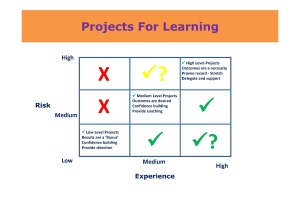Gary uses the experience of his five year old son learning how to ride a bicycle as a metaphor for leaders. Goals, strcutures and patience can combine to create the success that you desire.
Learning to ride a bicycle acts as a metaphor for leaders
“You’re doing it, you’re doing it! Well done son, you can ride your two-wheel bike. Woo hoo!”, I called with delight.
“Yeah! I can go for a run with you now Dad!”, called back my five year old son.
My son has had a goal to ride his bike without its training wheels so that he would be able to go on a run with me. For nearly his entire life his older brother and then his older sister have been going for a run with me (they ride their bikes while I run). Since he was three my five year old son has asked, “Can I come too?”. “Yes, when you can ride on two wheels” has been my response.
Achieving this goal has required re-enforcement, a clear structure and patience. The re-enforcement of the goal has occurred everytime my son asked if he could come on the run with me. The structure has been the rule that in order to ride his bike while I go running, he must be able to ride on two wheels.
Patience has been present while I have waited for him to want to practice riding on two wheels.
After he would ask if he could come on a run with me I would ask, “Would you like to practice now? I’m happy to practice with you before I go on my run.”
Honestly, I don’t know how many times I asked that question over the past two years only to hear, “Hmmm, not really. Maybe another day.”
I would always respond with a re-enforcement of his goal. “That’s okay. Just remember that if you want to come on a run with Daddy, then you have to be able to ride your bike without your training wheels.”
I had learnt with his two older siblings that as soon as they were the ones motivated to want to practice, then five days in a row of practice would guarantee success. I regularly reminded my son about this structure as well. “When you decide that you are ready, we just need five days in a row of practice and you’ll be able to ride your bike!”
As it happened he only needed three days! He was the one who said to me, “Come on Dad, I want to be able to ride my bike. I really want to go on a run with you!”. Broom stick in hand (which is a tool that I jam in behind the bike seat so that I can walk behind the bicycle and assist with balance), pedals off (turning the bicycle into a scooter which makes it easier and safer to learn how to balance) we went out into our street to practice. About 15 minutes each day was all that was required.
The goal and structures were easy to create. Maintaining patience was the most challenging part of this process. Not from his perspective, but from mine!
Relating this experience to leadership in the workplace
This is very similar to what often occurs in the workplace. Many leaders expect that the new structures that they implement will produce immediate results. Time delays are inevitable when change takes place. Performance may not improve, yet ‘time is ticking’. Unfortunately this results in many leaders not persisting with good programs and structures. Instead, they declare that the current structure ‘obviously doesn’t work’, so they switch to something else. This creates a cycle of changing structures that produce no measurable performance improvements over time.
A simple example of this relates to the concept of using conversation starters (see How to stimulate conversations that matter) to create ‘conversations that matter’. The goal may be to create a strong sense of the organisation’s values on a day to day level at work. The structure may be that the leader provides an example of the values in action as a hand-out to read before a team meeting. The meeting agenda may also include a section on ‘Our values’.
When the first meeting is held the leader asks, “What were your responses to the story in the hand-out?”. Silence. The leader shifts uncomfortably in their seat. The silence continues. So the leader quickly moves on to another agenda item.
After the meeting the leader declares, “Well, that conversation starter stuff certainly didn’t work! I’ll never do that again.” Leaders often do the same thing when it comes to creating team ground rules for the first time. Sound familiar?
Just because a new structure doesn’t produce immediate results when you try it, doesn’t mean that it won’t work. The important aspects to consider are:
1) Does the structure align with the goals that you are trying to create?
2) What leadership skills are necessary to support the structure?
3) How will those skills be developed?
4) What was learned each time the structure was practiced?
As you develop your leadership skills and learn which structures are most likely to produce the results that you desire, it is amazing how you can also learn how to combine goals, structures and patience to maintain focus even when performance doesn’t appear to be improving. But when it all comes together, the performance improvement can be exponential, just like the seemingly fast performance improvement that my son displayed when he finally started to ride his two-wheel bike. While it seemed fast, the final performance improvement occurred as a result of patience over a long period of time, a clear goal and structures to support that goal becoming a reality.
When you understand the interplay between these variables you discover that, ‘slower is faster’. Maintaining patience in the face of zero performance improvement can eventually create a performance improvement that otherwise is unlikely to occur. Many leaders can become seduced by the ‘sense of speed’ that often comes with trying something new, which is why they keep changing structures without giving them the proper time to be successful. Your challenge is to be clear about what you want to create, to develop structures to support your goals, to be patient and to never stop learning.While it may seem slow, this process is often a faster way to achieve performance improvement.
What are your examples where goals, structures and patience have combined to create the results that you desire?
Please feel free to ask questions and to make comments on this article.
Gary Ryan enables individuals, teams and organisations to matter.
Visit Gary at http://garyryans.com





 No matter how much practice you did, if you maintained this type of self talk you will have created a self-fulfilling prophecy. Moments in to your presentation your mind will go blank. Then it will fill with the words, “See, I knew I wasn’t any good at presenting and now look at what has happened! My mind has gone blank and the senior management team now thinks that I am useless!“
No matter how much practice you did, if you maintained this type of self talk you will have created a self-fulfilling prophecy. Moments in to your presentation your mind will go blank. Then it will fill with the words, “See, I knew I wasn’t any good at presenting and now look at what has happened! My mind has gone blank and the senior management team now thinks that I am useless!“ However, self talk is not enough. It must be balanced with doing the right work and focus. The right work in this example relates to learning how to do an effective presentation and putting what you learn in to practice before you do your presentation to the senior management team. Focus refers to the skills and structure that support the action that you are taking. In this example your focus would relate to the core message that you want to convey, the key supporting arguments that you have for your message and the call to action that you want the senior management team to adopt.
However, self talk is not enough. It must be balanced with doing the right work and focus. The right work in this example relates to learning how to do an effective presentation and putting what you learn in to practice before you do your presentation to the senior management team. Focus refers to the skills and structure that support the action that you are taking. In this example your focus would relate to the core message that you want to convey, the key supporting arguments that you have for your message and the call to action that you want the senior management team to adopt.
